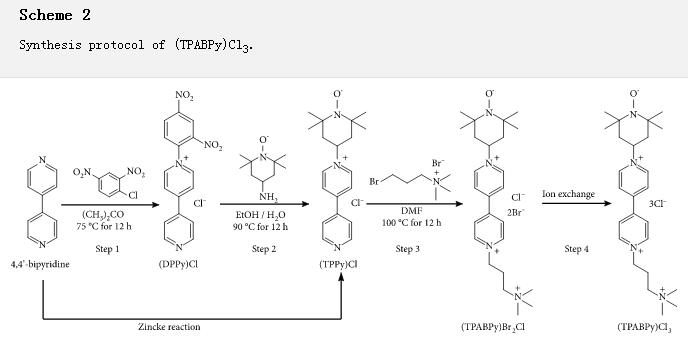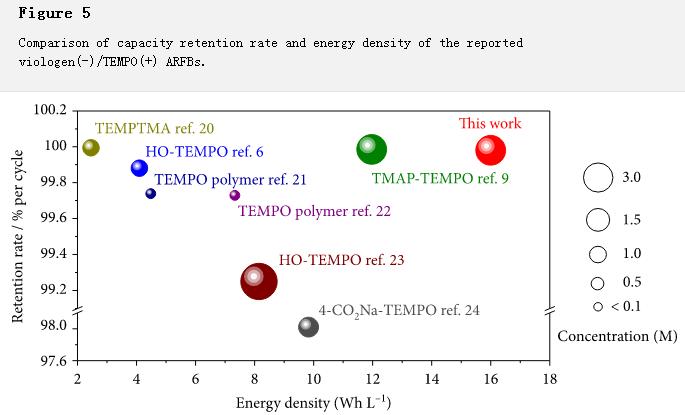博文
华南理工等新开发的化合物可持续、有效、大规模的能源储存
||
华南理工等新开发的化合物可持续、有效、大规模的能源储存
诸平

Aqueous redox flow battery. Credit: Liwen Wang, South China University of Technology



据北京理工大学出版社(Beijing Institute of Technology Press Co., Ltd)2021年11月12日提供的消息,华南理工大学(South China University of Technology)的研究人员与中山大学(Sun Yat-sen University)的研究人员合作新开发的化合物可以实现可持续的、具有成本效益的、大规模的能源储存(Newly developed compound may enable sustainable, cost-effective, large-scale energy storage)。
为了生产一种性价比高的氧化还原流体电池(redox flow battery),华南理工大学的研究人员合成了一种作为低成本电解质的分子化合物,使一种稳定的流体电池在每次循环中保持99.98%的容量。相关研究结果于2021年8月14日已经在《能源材料进展》(Energy Material Advances)杂志网站发表——Shuzhi Hu, Liwen Wang, Xianzhi Yuan, Zhipeng Xiang, Mingbao Huang, Peng Luo, Yufeng Liu, Zhiyong Fu, Zhenxing Liang. Viologen-Decorated TEMPO for Neutral Aqueous Organic Redox Flow Batteries. Energy Material Advances (2021). DOI: 10.34133/2021/9795237. http://dx.doi.org/10.34133/2021/9795237
该电池由两个相反的液体电解质罐组成,沿着夹在电极之间的膜分离器泵送正负液体,促进离子交换以产生能量。上述论文的通讯作者、华南理工大学化学与化学工程学院,广东省燃料电池技术重点实验室(Key Laboratory of Fuel Cell Technology of Guangdong Province, School of Chemistry and Chemical Engineering, South China University of Technology)梁振兴(Zhenxing Liang音译)教授表示,目前,人们对负电解质液体(negative electrolyte liquid)的开发做了大量的工作,而对正电解质液体(positive electrolyte liquid)的研究却很少。
梁教授说:“水氧化还原流体电池可以利用不稳定的太阳能和风能实现稳定的电能输出,已经被公认为一种有前景的大规模储能技术。电活性有机物的优点是元素丰富、成本低,对正负电解质的电化学特性进行灵活的分子控制,这被认为是开发下一代氧化还原流体电池的关键。”
梁教授和他的团队专注于TEMPO,这是一种很容易逆转氧化状态的化合物,具有很高的能量潜力,是正电解质的理想品质。
梁教授说:“然而,由于分子骨架的高疏水性,TEMPO不能直接应用于氧化还原液流电池。”他解释说,如果不进行改性,TEMPO不会溶解在促进液流电池能量交换所需的液体中。“我们开发了一种策略,将TEMPO与具有高度可逆氧化还原反应的有机化合物紫罗碱(viologen)功能化,以提高TEMPO的亲水性。”
梁教授表示,紫罗碱在水中的溶解性很强,增加了TEMPO在水中的溶解能力。紫罗碱还从原子伙伴中提取电子,这提高了它改变氧化状态的潜力。紫罗碱也是一种盐,它赋予TEMPO在水溶液中正如梁教授所说的那样,具有“良好导电性”。
当合成的紫罗碱改性TEMPO(viologen-modified TEMPO)在流体电池中测试时,研究人员发现电池每循环保留容量为99.98%,这意味着电池在不活跃使用时几乎可以保留所有存储的能量。
梁教授说:“这项工作通过氧化功能化克服了TEMPO的缺点,实现了它在水氧化还原流体电池中的应用。分子设计概念为新型有机电活性材料提供了策略,并为水性有机流体电池(aqueous organic flow battery)的应用奠定了基础。”
参与上述研究的除了华南理工大学的研究人员之外,还有来自中山大学材料科学与工程学院(School of Materials Science and Engineering, Sun Yat-sen University)。上述介绍,仅供参考。欲了解更多信息,敬请注意浏览原文或者相关报道。
Hybrid redox-flow battery with a long cycle life
A novel electroactive organic molecule, viz., 1-(1-oxyl-2,2,6,6-tetramethylpiperidin-4-yl)-1-(3-(trimethylammonio)propyl)-4,4-bipyridinium trichloride ((TPABPy)Cl3), is synthesized by decorating 2,2,6,6-tetramethylpiperidin-1-oxyl (TEMPO) with viologen, which is used as the positive electrolyte in neutral aqueous redox flow battery (ARFB). Extensive characterizations are performed to investigate the composition/structure and the electrochemical behavior, revealing the favorable effect of introducing the cationic viologen group on the electroactive TEMPO. Salient findings are as follows. First, the redox potential is elevated from +0.745 V for TEMPO to +0.967 V for decorated TEMPO, favoring its use as the positive electrolyte. Such an elevation originates from the electron-withdrawing effect of the viologen unit, as evidenced by the nuclear magnetic resonance and single crystal structure analysis. Second, linear sweep voltammetry reveals that the diffusion coefficient is , and the rate constant of the one-electron transfer process is . The two values are sufficiently high as to ensure low concentration and kinetics polarization losses during the battery operation. Third, the permeability through anion-exchange membrane is as low as . It is understandable as the positive-charged viologen unit prevents the molecule from permeating through the anion exchange membrane by the Donnan effect. Fourth, the ionic nature features a decent conductivity and thus eliminates the use of additional supporting electrolyte. Finally, a flow battery is operated with 1.50 M (TPABPy)Cl3 as the positive electrolyte, which affords a high energy density of 19.0 Wh L-1 and a stable cycling performance with capacity retention of 99.98% per cycle.
https://blog.sciencenet.cn/blog-212210-1312278.html
上一篇:化学家发现了利用氨能量的新方法
下一篇:MIT: 干细胞并非越大越好